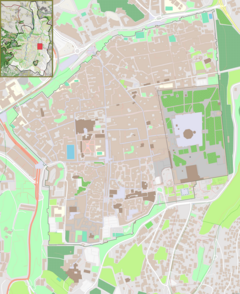Herod's Gate
This article needs additional citations for verification. (September 2014) |
| Herod's Gate | |
|---|---|
 Herod's Gate | |
| General information | |
| Town or city | Jerusalem |
| Coordinates | 31°46′58.8″N 35°14′1.5″E / 31.783000°N 35.233750°E |
Herod's Gate (
Names
Herod's Gate is the Christian name of the gate from the 16th or 17th century.[1] In Luke 23 (Luke 23:7), Jesus is sent by Pontius Pilate to the tetrarch Herod Antipas, and a Christian tradition associated a somewhat-nearby house near the Church of the Flagellation with Herod Antipas's palace.[1] Yet another tradition claimed that the nearby

Bāb az-Zāhra is the Arab Muslim name of the gate. In proximity to the gate is an Arab neighborhood called
Sha'ar HaPrakhim ('Flowers Gate') is the Hebrew name of the gate. Interpreted as a translation of the Arabic Bāb az-Zāhra, explained above, it would seem to be a misnomer.[6] However, the popular etymology of the Hebrew name connects it to the stone rosette which decorates the gate tower.
History
This modest gate, which opens from a wall tower, is one of the newest gates of Jerusalem. At the time when Suleiman the Magnificent built the city walls in the 1530s, a small wicket gate was situated in the eastern, lateral wall of the tower, which was rarely opened. Formerly, the sprawling residential area within this gate was known as Bezetha (effectually translated as "New City"), settled during the late Second Temple period to accommodate Jerusalem's growing population.[7] By 1875, in order to provide a passageway to the new neighborhoods which were beginning to develop north of the Old City, the Ottomans opened a new gate in the northern, frontal wall of the tower, which faces the Sultan Suleiman Street and offers easier access, and closed the original lateral gate.
In 1998 and during several subsequent excavation seasons (the latest in 2004), archaeologists of the Israel Antiquities Authority dug in the eastern area of Herod's Gate. The digging focused on three separate areas adjacent to the wall, in which nine archaeological layers were discovered – covering from the Iron Age up through the Ottoman period. Among the most significant discoveries were structures from the period of the Second Temple, a complete segment of the Byzantine-Roman wall, and remnants of massive construction underneath the wall. These remnants were identified as portions of a fortification from the ancient Muslim period and from the Middle Ages.[dubious ] These discoveries point out the importance which the rulers of the city gave to the fortification of one of its most sensitive places—the northern wall of Jerusalem. Indeed, historical accounts indicate that in 1099 the Crusader army under Godfrey of Bouillon entered the city through a breach located slightly east of the present Herod's Gate.[citation needed]
See also
References
- ^ ISBN 978-0-19-164766-6.
[Herod's Gate] got its present name only in the C16 or C17 because pilgrims believed a Mamluk house inside near the Franciscan Monastery of the Flagellation to be the palace of Herod Antipas.
- ISBN 978-0-521-39038-5.
... Herod Antipas and that in the Middle Ages the building was identified as the house of Herod […] However, […] there is no certain evidence to suggest that it was ever associated with the Dair al-ʿAdas before the later nineteenth century. Around that time the Dair al-ʿAdas assumed that identity from another house standing some 90 m west of it
- ^ Eliyahu Wager (1988). Illustrated guide to Jerusalem. Jerusalem: The Jerusalem Publishing House. pp. 82–83.
- ISBN 9780520207684. Retrieved 29 August 2015.
- ISBN 9780486414256. Retrieved 29 August 2015.
The verb 'sahira' means "to be watchful," and there are passages in the Koran which speak of the newly risen on the Day looking around watching expectantly for what will come next. The common opinion, however, is that 'as-Sahira' here is a proper noun, the name of that wide ope plain on which men will be assembled for Judgement, in which case one should translate;"there they are at as-Sahira."
- ^ Stephan Hanna Stephan, Boulos Afif and Eugene Hoade, This is Palestine: A Concise Guide to the Important Sites in Palestine, Transjordan and Syria (2nd ed.) (Jerusalem: The Modern Press, 1947), 105
- ^ Josephus, De Bello Judaico (Wars of the Jews) v.iv.§ 2

